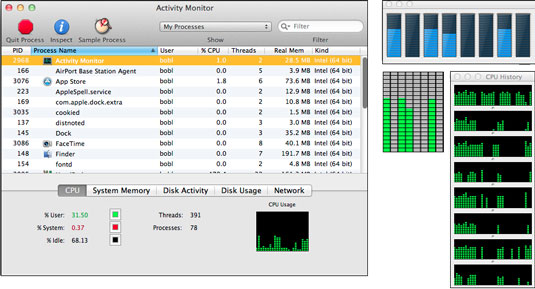Activity Monitor in OS X Mountain Lion
In Unix, the underlying operating system that runs OS X and the applications and other things that happen behind the scenes are called processes. Each application and the operating system itself can run a number of processes at the same time.
In the following figure, you see 78 different processes running, most of them behind the scenes. Note that when this photo was taken, six or more programs were running, including Finder, FaceTime, the Mac App Store, and Activity Monitor itself.

To display the three CPU Monitor windows on the right side of the Activity Monitor window as shown, choose Window → CPU Usage (Command + 2), CPU History (Command + 3), and/or Floating CPU Window (No keyboard shortcut).
You can also specify what appears in the Activity Monitor Dock icon — CPU usage, CPU history, network usage, disk activity, memory usage, or Activity Monitor icon — by choosing View → Dock icon. All but the Activity Monitor icon appear live, which means that they are updated every few seconds to reflect the current situation.
To choose how often these updates occur, choose View → Update Frequency.
But be careful – setting Activity Monitor to refresh more frequently will use more CPU cycles, which can slightly reduce overall performance.
Finally, the bottom of the Activity Monitor window can display one of five screens. Simply click on the appropriate tab – CPU, System Memory, Disk Activity, Disk Usage, or Network – to see that specific screen.
Since all Macs that can run Mountain Lion have at least a dual-core processor, you’ll see at least two, possibly four or more CPUs displayed in the Activity Monitor, one for each core.
Geeks and troubleshooters (and even you) can use Activity Monitor to determine which processes are running, who owns the process, and how much CPU and memory the process is using. You can even use this feature to terminate or force termination of a process that you think might be causing you problems.
Messing around with Activity Monitor is not a good idea for most users. If you’re having problems with an app or with OS X, try to quit open apps; Force terminate applications (press Command + Option + Esc – “Three Fingers Salute” for Mac); Or log out and log back in before you start fiddling with processes.
